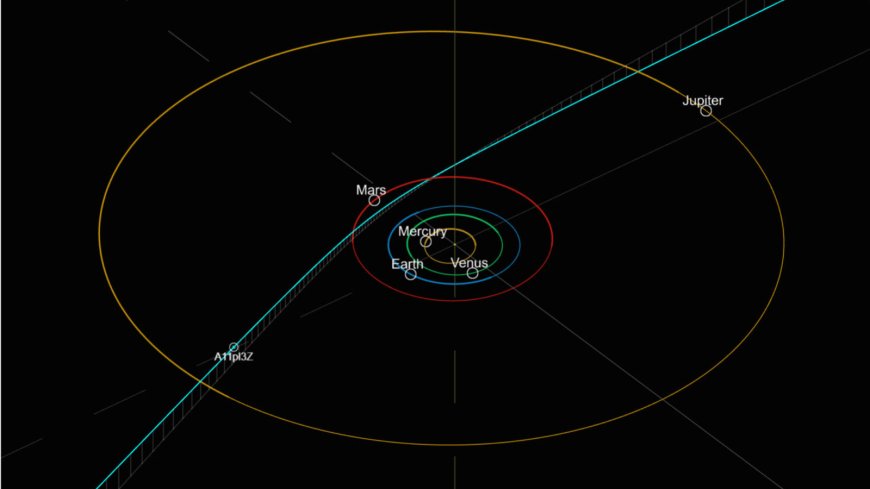NASA Confirms Interstellar Visitor 3I/ATLAS Speeding Through Solar System
NASA scientists have confirmed the discovery of interstellar object 3I/ATLAS, previously known as A11pl3Z, racing towards the sun before exiting the solar system. This cosmic interloper, predicted to be a comet, is the third of its kind ever detected. Follow its journey through the solar system and upcoming livestream events for a closer look.

The newly discovered interstellar object 3I/ATLAS (previously dubbed A11pl3Z) is predicted to shoot past the sun before eventually exiting the solar system.
NASA scientists have confirmed that a mysterious object shooting toward us through the solar system is an 'interstellar object' — only the third of its kind ever seen. Experts have also given the cosmic interloper an official name, and revealed new information about its origins and trajectory.
News of the extrasolar entity, initially dubbed A11pl3Z, broke on Tuesday (July 1), when NASA and the International Astronomical Union (IAU) both listed it as a confirmed object. It was first discovered in data collected between June 25 and June 29 by the Asteroid Terrestrial-impact Last Alert System (ATLAS), which automatically scans the night sky using telescopes in Hawaii, Chile and South Africa. Multiple telescopes across the world have subsequently spotted the object in observation data that date back to June 14.
The object is traveling toward the sun extremely fast, at around 152,000 mph (245,000 km/h), and observations suggest that it is set on an extremely flat and straight trajectory, unlike anything else in the solar system. This led many experts to speculate that it originated from beyond the sun's gravitational influence and has enough momentum to shoot straight through our cosmic neighborhood without slowing down.
On Wednesday (July 2), NASA released a statement confirming that A11pl3Z is indeed an interstellar object and will not remain in the solar system for long. The researchers also shared the object's new official name, 3I/ATLAS, and revealed that it is most likely a comet, upending previous assumptions that it was an asteroid. The object's full comet name is C/2025 N1 (ATLAS).
Until now, only two confirmed interstellar visitors have ever been spotted: Comet 2I/Borisov, which was seen sailing through the solar system in 2019; and 'Oumuamua, a cigar-shaped object that made headlines in 2017 when some astronomers argued it was potentially an alien probe, before experts showed it was most likely a hydrogen-spewing space rock.
But scientists have long suspected that many more interstellar interlopers likely pass through our cosmic neighborhood without ever being detected.
The first images of 3I/ATLAS suggested that it may have been an asteroid. However, NASA now predicts that it is a comet.
Researchers initially suspected that 3I/ATLAS was an asteroid, like 'Oumuamua. However, the object has displayed 'tentative signs of cometary activity' like 2I/Borisov — including being surrounded by a bright cloud of gas and ice, known as a coma, and having what looks like a tail — according to the IAU's Minor Planet Center. However, more observations are needed to confirm this.
There has been no additional information about the potential comet's size or shape: The current best guess is that it could be up to 12 miles (20 kilometers) across. However, NASA has revealed updated information about its upcoming journey through the solar system.
3I/ATLAS is currently around 4.5 times as far from the sun as Earth is. It will reach its closest point to the sun, or perihelion, on Oct. 30, coming within 1.4 Earth-sun distances, or astronomical units (AU), of our home star. Shortly before this happens, the comet will also make its closest approach to Mars, coming within 0.4 AU of the Red Planet.
Earth will be on the opposite side of the sun to 3I/ATLAS during its solar flyby. The comet will likely make its closest approach to Earth in December, on its journey back out of the solar system. As a result, 'the comet poses no threat to Earth and will remain at a minimum distance of at least 1.6 astronomical units,' NASA officials wrote in the statement.
The interloper is currently too faint to see with amateur stargazing equipment, but it may brighten significantly in the coming weeks and months. However, you can watch it shoot through the solar system via an upcoming livestream from the Virtual Telescope Project, starting at 6:00 p.m. EST on Thursday (July 3).
3I/ATLAS is now 'being investigated by astronomers around the world,' NASA officials wrote. Researchers will be able to study it until the end of September, when it will become obscured by the sun's light, and again from December onwards when the comet reemerges from behind our home star.
According to the source: Live Science.
What's Your Reaction?
 Like
0
Like
0
 Dislike
0
Dislike
0
 Love
0
Love
0
 Funny
0
Funny
0
 Angry
0
Angry
0
 Sad
0
Sad
0
 Wow
0
Wow
0







































































































































































